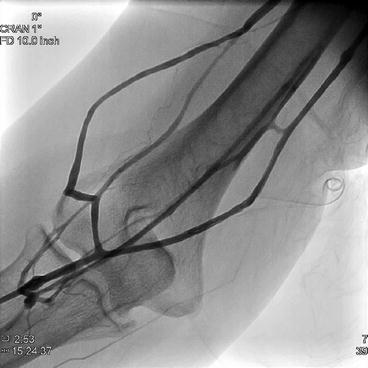Figure 41.1
(a, b) Ultrasound mapping of veins, performed in the office (Courtesy of David Melnick, MD)
In most cases, a vein 2.5–3 mm or larger would be appropriate to attempt an operation, while an artery 2–2.5 mm at a minimum may work, although larger vessels size will predict a greater likelihood of success [4]. You can gain more information and detail by performing the ultrasound yourself rather than depending upon a radiology report. In patients with a history of multiple failed attempts at access, a concern for central venous stenosis, or other factors that may make the access more likely to fail, a venogram with iodinated contrast or CO2 may also help delineate the anatomy of the venous system including the central venous system to plan the operation (Fig. 41.2).


Figure 41.2
Right upper arm venogram using iodinated contrast demonstrating the cephalic vein (upper left) brachial vein (middle) and basilic vein (lower right) (Courtesy of Amanda Valliant, MD)
Positioning and Anesthesia
You can perform the operations utilizing local anesthesia with sedation (or sometimes without sedation,) monitored anesthesia care, or a regional block. Place the operative arm in the abducted position on an arm board and prep and drape appropriately.
Description of the Procedure
Wrist Fistula (Radiocephalic Fistula)
Dr. Kenneth Appel, a general surgeon in The Bronx in New York City, performed the first radiocephalic wrist fistula (also known as the Brescia-Cimino-Appel fistula) in 1963 [5]. He improved upon the other option at that time, the Scribner Shunt, an external metallic shunt placed in the forearm associated with significant major complications. The patient should have a normal Allen’s test to prevent ischemic complications to the hand. A preoperative ultrasound can sometimes identify an area more proximal than the wrist where the vein and/or artery may have a larger diameter and be easier to work with. After prepping, draping, and anesthetizing, incise the skin longitudinally between the cephalic vein and the palpable radial artery in the distal forearm. Develop a lateral skin flap to expose the cephalic vein. Mobilize it for a distance of 4–5 cm and control it with vessel loops. To expose the radial artery, palpate it or use a Doppler to identify it then incise the overlying fascia. Preserve the superficial branch of the radial nerve lying lateral to the artery as it supplies sensation to the thumb. Mobilize the artery and gain proximal and distal control with vessel loops. Depending on the quality and location of the vein, you can perform either a side to side or end vein to side artery anastomosis. The initial description of this procedure by Appel utilized a side to side anastomosis, but this chapter will describe an end vein to side artery anastomosis. Divide the vein distally at the appropriate point to prepare for the anastomosis. Locally heparinize the vein and sequentially dilate to 4–5 mm with vessel dilators to ensure lack of stenosis, then heparinize again and place a bulldog on the vein. Some authors recommend a different approach, limiting trauma to the vein and artery by minimizing the contact with them around the area of the anastomosis.
Elbow Fistula (Brachiocephalic Fistula)
After prepping and draping, anesthetize the skin just distal to the antecubital crease and incise the skin transversely at that location. Dissect though the subcutaneous fat to expose the cephalic vein and mobilize it proximally and distally. Often you will find the cephalic vein anastomosing to the basilic vein in an arch formation, with distal venous branches. Using a branch point of the cephalic vein can help with an easier anastomosis. After exposing the vein, palpate or Doppler medially to find the brachial artery and brachial veins then incise the overlying bicipital aponeurosis (lacertus fibrosus) to expose them. Mobilize the artery and gain control with vessel loops. You can expose distally and gain control of the proximal radial artery to perform the anastomosis there, with the potential advantage of a lower risk of steal syndrome, or use the main brachial artery for the anastomosis. Ligate and divide small arterial branches to prevent avulsion. Gain proximal and distal control of the artery with vessel loops. Divide the vein distally at the appropriate point to prepare for the anastomosis. Locally heparinize the vein and sequentially dilate to 4–5 mm with vessel dilators to ensure lack of stenosis, then heparinize again and place a bulldog on the vein.
Stay updated, free articles. Join our Telegram channel

Full access? Get Clinical Tree








